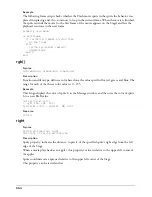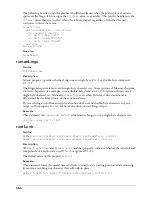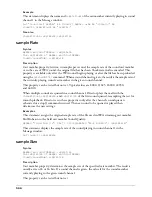
559
rootNode
Syntax
member(
whichCastmember
).camera(
whichCamera
).rootNode
sprite(
whichSprite
).camera.rootNode
Description
3D property; allows you to get or set which objects are visible within a sprite. When a camera is
first created, it shows all nodes within the world. The
rootNode
property allows you to modify this
by creating a different default view that limits what’s shown to a particular node and its children.
For example, light C is a child of model A., if you set the
rootNode
property to
camera("defaultView").rootNode=model(A)
, the sprite will show only model A as illuminated by
light C. The default is
group("world")
, meaning that all nodes are used.
Example
The following statement sets the
rootNode
of the camera of sprite 5 to the model Pluto. Only
Pluto and its children will be visible in sprite 5.
sprite(5).camera.rootNode = member("Scene").model("Pluto")
rotate
Syntax
member(
whichCastmember
).node(
whichNode
).rotate(
xAngle
,
yAngle
, \
zAngle
{,
relativeTo
})
member(
whichCastmember
).node(
whichNode
).rotate(
rotationVector
\
{,
relativeTo
})
member(
whichCastmember
).node(
whichNode
).rotate(
position, axis,
\
angle
{,
relativeTo
})
transform
.rotate(
xAngle
,
yAngle
,
zAngle
{,
relativeTo
})
transform
.rotate(
rotationVector
{,
relativeTo
})
transform
.rotate(
position
,
axis
,
angle
{,
relativeTo
})
Description
3D command; applies a rotation after the current positional, rotational, and scale offsets held by
the node’s transform object or the directly referenced transform object. The rotation must be
specified as a set of three angles, each of which specify an angle of rotation about the three
corresponding axes. These angles may be specified explicitly in the form of
xAngle
,
yAngle
, and
zAngle
, or by a
rotationVector
, where the
x
component of the vector corresponds to the rotation
about the X axis,
y
about Y axis, and
z
about Z axis. Alternatively, the rotation may also be
specified as a rotation about an arbitrary axis passing through a point in space. This axis is
defined in space by
position
, representing a position in space and
axis
, representing an axis
passing through the specified position in space. The amount of rotation about this axis is
specified by
angle
.
The optional
relativeTo
parameter determines which coordinate system axes are used to apply the
desired rotational changes. The
relativeTo
parameter can have any of the following values:
•
#self
applies the increments relative to the node’s local coordinate system (the X, Y and Z axes
specified for the model during authoring). This value is used as the default if you use the
rotate
command with a node reference and the
relativeTo
parameter is not specified.
•
#parent
applies the increments relative to the node’s parent’s coordinate system. This value is
used as the default if you use the
rotate
command with a transform reference and the
relativeTo
parameter is not specified.
Summary of Contents for DIRECTOR MX-LINGO DICTIONARY
Page 1: ...Lingo Dictionary Macromedia Director MX...
Page 756: ...Index 756...
















































